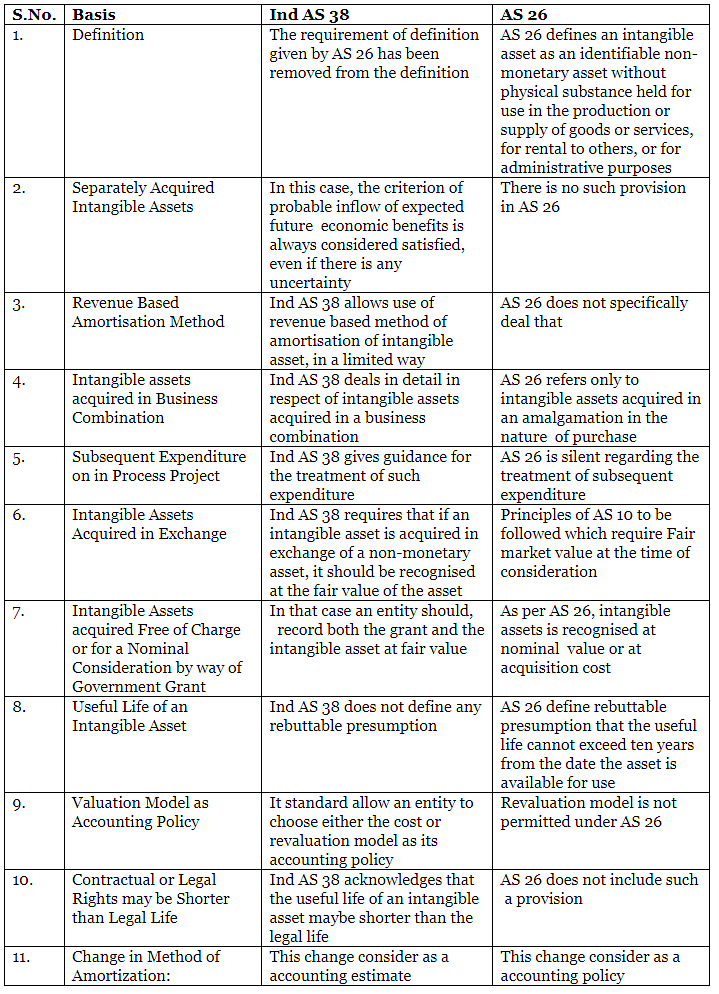AS 26 – Intangible Assets | Advanced Accounting for CA Intermediate PDF Download
| Table of contents |

|
| Introduction |

|
| Recognition and Measurement |

|
| Initial and Subsequent Expenditure |

|
| Amortization Period |

|
| Retirements and Disposals |

|
| Significant Differences in IND AS 38 and AS 26 |

|
Introduction
An intangible asset is a non-physical, non-monetary asset held for use in the production or supply of goods and services, or for rental purposes. AS 26 is applicable to all enterprises for the accounting of intangible assets, with the following exceptions:
- Intangible assets that fall under the scope of another standard for financial assets.
- Rights and expenditures related to the exploration or development of minerals, oil, natural gas, and similar non-renewable resources.
- Intangible assets arising from insurance contracts with policyholders.
- Expenditures related to termination benefits.
Recognition and Measurement
The criteria apply when an item qualifies as an intangible asset, it is likely that future economic benefits will flow to the enterprise, and the asset's cost can be reliably measured. These recognition criteria pertain to the cost of both acquiring and internally generating an intangible asset.
Note: If an intangible asset is acquired separately, it should initially be measured at cost. This cost includes the purchase price, import duties, non-refundable purchase taxes, less any trade discounts and related direct costs. If an asset is acquired as part of a business combination, its cost should be its fair value at the acquisition date, based on market expectations. When an asset is acquired free of charge or for nominal consideration through a government grant, it is recognized at either a nominal value or the acquisition cost. The cost of an internally generated intangible asset encompasses all direct expenditures related to creating, producing, and preparing the asset for its intended use from the time it meets the first recognition criteria.
Initial and Subsequent Expenditure
- Recognition of Expenditure
Expenditure related to intangible assets should be treated as an expense when it is initially incurred. This means that when the cost is first accrued, it should be recorded as an expense on the financial statements.
- Subsequent Expenditure Treatment
Subsequent expenditure, which occurs after the purchase or completion of the asset, should be capitalized by adding it to the cost of the intangible asset. This is done when there is a likelihood that the additional expenditure will result in future economic benefits and when the amount spent can be reliably measured.
Amortization Period
Amortization refers to the process of spreading the cost of an intangible asset over its useful life. It should commence once the asset is ready for use. The depreciable amount of the intangible asset is distributed based on its useful life. According to accounting standards, intangible assets are generally assumed to have a useful life not exceeding ten years, although there are exceptions where this period could be longer.
To explain further, let's consider a software company that purchases a patent for a new technology. The company estimates that the patent will remain valuable for at least 15 years. In this case, the company would amortize the cost of the patent over the 15-year period to reflect its gradual consumption of economic benefits.
Retirements and Disposals
An intangible asset is removed from the books either upon disposal or when there are no expected future economic benefits from its use. Any resulting gain or loss should be reflected in the income statement.
Example:
An enterprise incurred costs to develop and produce a software product during 2017-18, as follows:

To determine the amount to be capitalized as software costs on the balance sheet date, costs incurred in creating the software product should be expensed until certain criteria are met. Per AS 26, costs are initially expensed until technological feasibility/asset recognition criteria are established.
In the given scenario, ₹75,000 would be expensed (₹45,000 + ₹30,000) until the technological feasibility criteria are met. Costs incurred after this point and until product costs are incurred should be capitalized as software costs (₹40,000 + ₹10,000 + ₹15,000 = ₹65,000).
Significant Differences in IND AS 38 and AS 26

|
53 videos|134 docs|6 tests
|
FAQs on AS 26 – Intangible Assets - Advanced Accounting for CA Intermediate
| 1. What is the difference between recognition and initial measurement of an intangible asset in AS 26? |  |
| 2. How does AS 26 treat initial and subsequent expenditure related to intangible assets? |  |
| 3. What is the amortization period for intangible assets under AS 26? |  |
| 4. How does AS 26 address retirements and disposals of intangible assets? |  |
| 5. What are the significant differences between IND AS 38 and AS 26 in relation to intangible assets? |  |




















